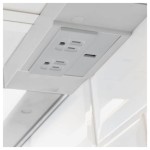How to Change Your Kitchen Faucet
Replacing a kitchen faucet is a common home improvement task that can significantly enhance both the functionality and aesthetics of a kitchen. While professional plumbing assistance is always an option, the process is often manageable for homeowners with basic plumbing knowledge and the right tools. This article provides a comprehensive guide to changing a kitchen faucet, outlining the necessary preparations, the step-by-step removal of the old faucet, and the installation of the new one. Careful adherence to these instructions will help ensure a successful and leak-free faucet replacement.
Before embarking on the replacement process, gathering the necessary tools and materials is essential. This proactive step minimizes interruptions and ensures a smooth workflow. The required tools typically include:
- Adjustable wrench: For loosening and tightening plumbing connections.
- Basin wrench (faucet wrench): Specifically designed for accessing hard-to-reach nuts under the sink.
- Pliers: Useful for gripping and manipulating various plumbing components.
- Screwdrivers (Phillips and flathead): For removing mounting hardware and other fasteners.
- Utility knife: To cut through old caulk or sealant.
- Bucket or container: To catch water during disconnection.
- Towels or rags: For cleanup and to protect the work area.
- Plumber's putty or silicone sealant: To create a watertight seal around the faucet base.
- Teflon tape (pipe thread sealant): To seal threaded connections, preventing leaks.
- Safety glasses: To protect eyes from debris.
- Gloves: To protect hands from dirt and potential irritants.
In addition to the tools, the new kitchen faucet and its accompanying parts must be readily available. Prior to purchase, ensure the new faucet is compatible with the existing sink configuration (number of holes, hole spacing). Verify that all necessary mounting hardware, supply lines (if needed), and drain components (if applicable) are included with the new faucet.
Key Point 1: Preparing for Faucet Replacement
The initial steps in changing a kitchen faucet involve preparing the workspace and shutting off the water supply. These preparatory actions are crucial for safety and preventing water damage. Failure to properly prepare can lead to significant water leakage and potential property damage.
The first step is to clear the area beneath the sink. Remove all items stored in the cabinet to provide ample working space. Placing a drop cloth or old towels beneath the sink will protect the cabinet floor from water spills and potential damage. Good lighting is essential; utilize a work light or flashlight to illuminate the area effectively.
The most critical preparation step is to shut off the water supply to the faucet. Locate the shut-off valves under the sink, typically connected to the hot and cold water supply lines. Turn both valves clockwise until they are completely closed. After closing the valves, turn on the existing faucet briefly to relieve any remaining pressure in the lines. If the shut-off valves are old or corroded and do not completely stop the water flow, it may be necessary to shut off the main water supply to the entire house. Locate the main water shut-off valve (usually in the basement, garage, or near the water meter) and turn it off. Test the faucet again to confirm that the water flow has completely stopped.
Once the water supply is secured, disconnect the existing supply lines from the faucet. Place a bucket or container beneath the connections to catch any residual water. Use an adjustable wrench to loosen the connections. If the connections are corroded or difficult to loosen, penetrating oil can be applied to help break the seal. Be cautious not to damage the water supply lines during disconnection. If the supply lines are damaged or corroded, it is recommended to replace them with new ones during the faucet replacement.
Key Point 2: Removing the Old Faucet
With the water supply disconnected, the next step is to remove the old faucet from the sink. This process involves disconnecting any spray hose, loosening the mounting hardware, and carefully lifting the faucet away from the sink.
If the old faucet has a side sprayer, disconnect the spray hose from the faucet body. Typically, this involves a clip or a threaded connection. Be prepared for some water to spill when disconnecting the hose. Some sprayers are integrated directly into the faucet body and may not require a separate disconnection step.
Locate and loosen the mounting hardware that secures the faucet to the sink. This hardware is usually located beneath the sink and consists of nuts, washers, and mounting plates. A basin wrench is often necessary to reach these nuts, especially in tight spaces. Position the basin wrench around the nut and turn it counterclockwise to loosen it. Due to corrosion, these nuts can be difficult to remove. Applying penetrating oil and allowing it to soak for a few minutes can help loosen stubborn nuts. If the nuts are severely corroded, it may be necessary to use a hacksaw or a nut splitter to remove them. Exercise caution when using these tools to avoid damaging the sink or surrounding plumbing.
Once all the mounting hardware is removed, the old faucet should be free to lift away from the sink. Before lifting the faucet, use a utility knife to carefully cut through any caulk or sealant around the base of the faucet. This will prevent damage to the sink surface. Lift the faucet straight up and away from the sink. If the faucet is stuck, gently rock it back and forth to break the seal. Avoid using excessive force, which could damage the sink.
After removing the old faucet, thoroughly clean the sink surface around the faucet holes. Remove any remaining sealant, debris, or mineral deposits. Use a non-abrasive cleaner and a soft cloth to avoid scratching the sink surface. Inspect the sink for any damage, such as cracks or chips. Repair any damage before installing the new faucet.
Key Point 3: Installing the New Faucet
With the old faucet removed and the sink surface cleaned, the final step is to install the new faucet. This involves attaching the new faucet to the sink, connecting the water supply lines, and testing for leaks. Proper installation is crucial for ensuring a leak-free and functional faucet.
Follow the manufacturer's instructions to assemble the new faucet components. This may involve attaching the spout, handle(s), and base plate. Apply plumber's putty or silicone sealant around the base of the faucet where it will contact the sink. This creates a watertight seal and prevents water from seeping under the faucet. Center the faucet over the sink holes and carefully lower it into place. Ensure that the faucet is properly aligned and that the handle(s) operate smoothly.
From beneath the sink, attach the mounting hardware to secure the new faucet to the sink. This typically involves tightening nuts and washers onto the faucet's mounting studs. Use a basin wrench to tighten the nuts, ensuring that the faucet is firmly secured to the sink. Avoid overtightening the nuts, which could damage the sink or the faucet. Check the faucet's alignment and handle operation again after tightening the mounting hardware.
Connect the water supply lines to the new faucet. If the old supply lines are in good condition, they can be reused. However, it is generally recommended to replace the supply lines with new ones during the faucet replacement. This ensures a reliable connection and prevents leaks. Apply Teflon tape to the threads of the faucet's water inlets. This creates a waterproof seal and prevents leaks. Connect the supply lines to the faucet inlets, tightening the connections with an adjustable wrench. Avoid overtightening the connections, which could damage the supply lines or the faucet.
If the new faucet has a side sprayer, connect the spray hose to the faucet body. Follow the manufacturer's instructions for connecting the spray hose. Ensure that the connection is secure and that the sprayer operates smoothly.
Once all connections are made, slowly turn on the water supply at the shut-off valves. Check for leaks at all connections, including the supply lines, the faucet base, and the spray hose (if applicable). If any leaks are detected, tighten the connections or reapply Teflon tape to the threads. If the leaks persist, consult a plumber.
After verifying that there are no leaks, test the faucet's operation. Turn the faucet on and off, and check the water flow and temperature. Ensure that the handle(s) operate smoothly and that there are no unusual noises. If the faucet has a sprayer, test its operation as well.
Finally, clean up the work area. Remove any debris, tools, and materials. Wipe down the sink and surrounding surfaces. Dispose of the old faucet and any packaging materials properly.

How To Replace A Kitchen Sink Faucet Youtube

How To Replace A Kitchen Faucet

How To Replace A Kitchen Faucet

How To Replace A Kitchen Faucet Young House Love

How To Install A Kitchen Faucet Lowe S

How To Replace A Kitchen Faucet Green House Plumbing

How To Change A Kitchen Faucet Family Handyman

How To Replace A Kitchen Faucet For Newbies Anika S Diy Life

How To Replace A Kitchen Faucet

How To Install A Kitchen Faucet The Home
See Also








